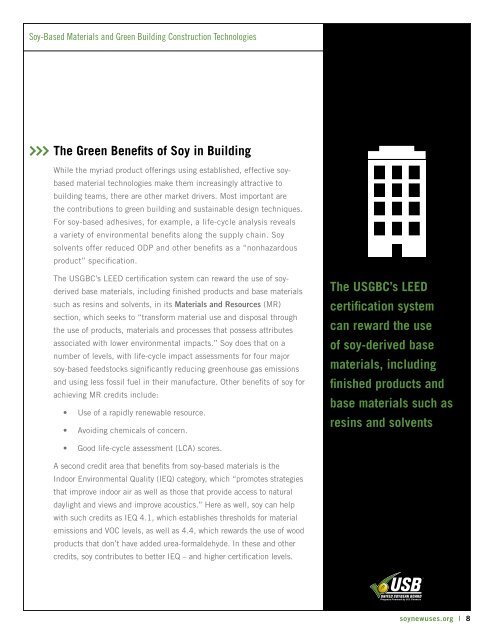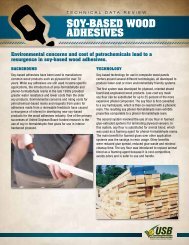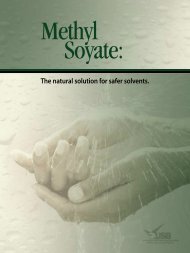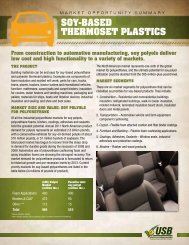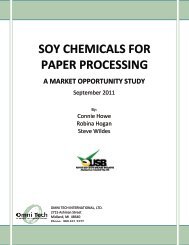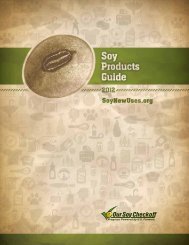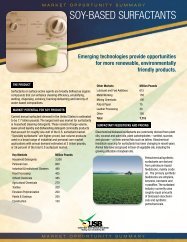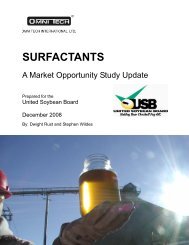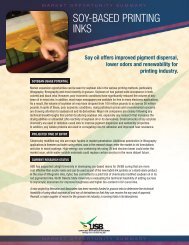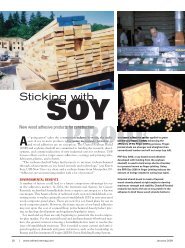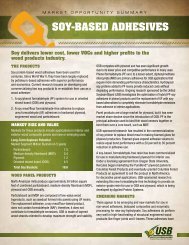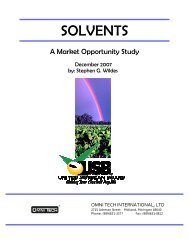Soy-Based Materials and Green Building ... - Soy New Uses
Soy-Based Materials and Green Building ... - Soy New Uses
Soy-Based Materials and Green Building ... - Soy New Uses
You also want an ePaper? Increase the reach of your titles
YUMPU automatically turns print PDFs into web optimized ePapers that Google loves.
<strong>Soy</strong>-<strong>Based</strong> <strong>Materials</strong> <strong>and</strong> <strong>Green</strong> <strong>Building</strong> Construction Technologies<br />
The <strong>Green</strong> Benefits of <strong>Soy</strong> in <strong>Building</strong><br />
While the myriad product offerings using established, effective soybased<br />
material technologies make them increasingly attractive to<br />
building teams, there are other market drivers. Most important are<br />
the contributions to green building <strong>and</strong> sustainable design techniques.<br />
For soy-based adhesives, for example, a life-cycle analysis reveals<br />
a variety of environmental benefits along the supply chain. <strong>Soy</strong><br />
solvents offer reduced ODP <strong>and</strong> other benefits as a “nonhazardous<br />
product” specification.<br />
The USGBC’s LEED certification system can reward the use of soyderived<br />
base materials, including finished products <strong>and</strong> base materials<br />
such as resins <strong>and</strong> solvents, in its <strong>Materials</strong> <strong>and</strong> Resources (MR)<br />
section, which seeks to “transform material use <strong>and</strong> disposal through<br />
the use of products, materials <strong>and</strong> processes that possess attributes<br />
associated with lower environmental impacts.” <strong>Soy</strong> does that on a<br />
number of levels, with life-cycle impact assessments for four major<br />
soy-based feedstocks significantly reducing greenhouse gas emissions<br />
<strong>and</strong> using less fossil fuel in their manufacture. Other benefits of soy for<br />
achieving MR credits include:<br />
• Use of a rapidly renewable resource.<br />
• Avoiding chemicals of concern.<br />
The USGBC’s LEED<br />
certification system<br />
can reward the use<br />
of soy-derived base<br />
materials, including<br />
finished products <strong>and</strong><br />
base materials such as<br />
resins <strong>and</strong> solvents<br />
• Good life-cycle assessment (LCA) scores.<br />
A second credit area that benefits from soy-based materials is the<br />
Indoor Environmental Quality (IEQ) category, which “promotes strategies<br />
that improve indoor air as well as those that provide access to natural<br />
daylight <strong>and</strong> views <strong>and</strong> improve acoustics.” Here as well, soy can help<br />
with such credits as IEQ 4.1, which establishes thresholds for material<br />
emissions <strong>and</strong> VOC levels, as well as 4.4, which rewards the use of wood<br />
products that don’t have added urea-formaldehyde. In these <strong>and</strong> other<br />
credits, soy contributes to better IEQ – <strong>and</strong> higher certification levels.<br />
soynewuses.org | 8


